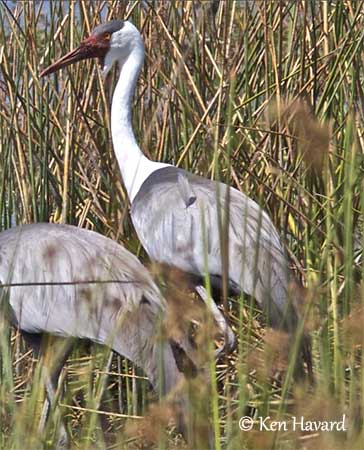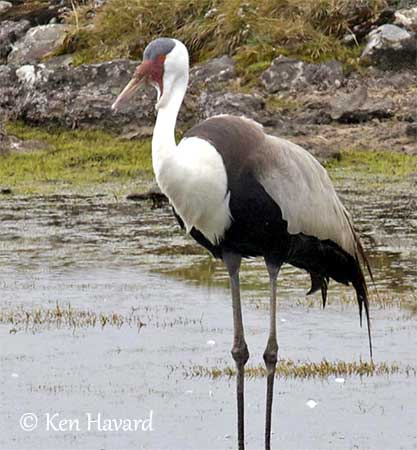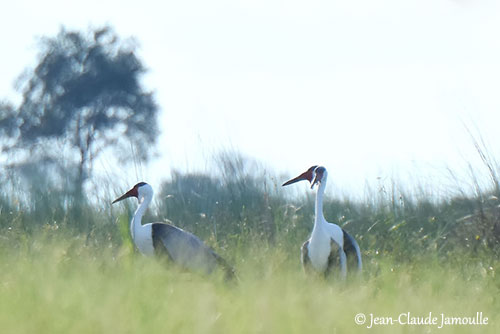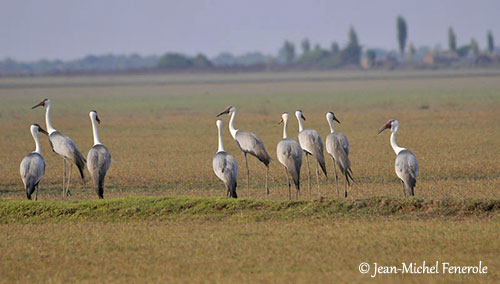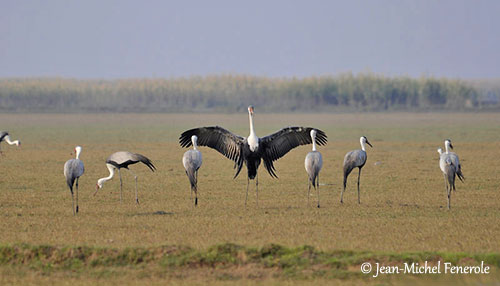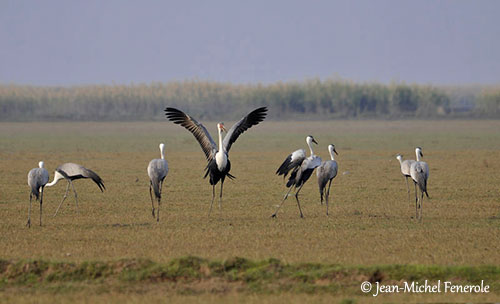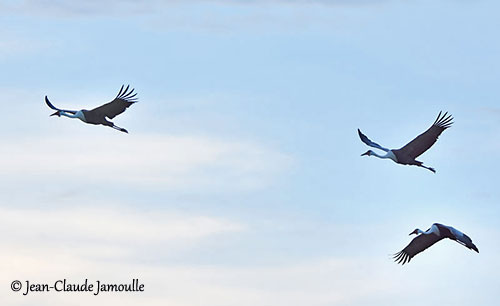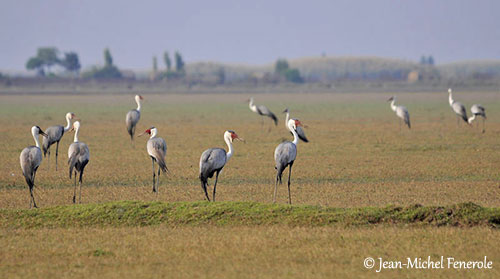
Fr: Grue caronculée
All : Klunkerkranich
Esp : Grulla Carunculada
Ital: Gru caruncolata
Nd: Lelkraanvogel
Sd: Vårttrana
Photographers:
Jean Michel Fenerole
Photos d’Oiseaux du monde
Ken Havard
My Bird Gallery & Flickr gallery 1 & Flickr gallery 2
Jean-Claude Jamoulle
A la rencontre des Oiseaux
Texte de Nicole Bouglouan
Sources:
HANDBOOK OF THE BIRDS OF THE WORLD Volume 3 by Josep del Hoyo-Andrew Elliott-Jordi Sargatal - Lynx Edicions - ISBN : 8487334202
BIRDS OF AFRICA SOUTH OF THE SAHARA by Ian Sinclair and Peter Ryan - Princeton University Press Princeton and Oxford - ISBN: 0691118159
BirdLife International (BirdLife International)
International Crane Foundation
The Department of Biodiversity & Conservation Biology
The University of the Western Cape
Northern Prairie Wildlife Research Center
Wattled Crane
Grus carunculatus
Gruiforme Order – Gruidae Family
BIOMETRICS:
Length: 175 cm
Wingspan: 230-260 cm
Weight: M: 8300-8500 g – F: 7100-7900 g
DESCRIPTION:
The Wattled Crane is one of the largest cranes’ species, the second after the Sarus Crane and the largest of the African species.
This species is listed as Vulnerable with rapid declines in its small population.
Adult has grey upperparts and wings. The secondary flight feathers are elongated, extending beyond the tail and almost to the ground. Flight feathers and tail are dark grey to blackish. The upperback is darker grey.
This crane has white neck and breast, contrasting with the black underparts and the dark grey upper mantle.
On the head, forehead and forecrown are grey. We can see a red facial patch of grainy bare skin around the bill base and on the lores, extending along the front of two conspicuous white-feathered large wattles.
The straight bill is long and horn-coloured. The eyes are red-orange. Legs and feet are dark grey to blackish.
Both sexes are similar in plumage, but male is larger than female.
The juvenile has tawny body plumage. The red facial pattern is absent and the wattles are less prominent. The crown is white and the flight feathers are shorter.
VOICE: SOUNDS BY XENO-CANTO
The Wattled Crane is mostly silent, but it can utter loud, far-carrying “kwaarnk” and high-pitched piercing calls.
HABITAT:
The Wattled Crane depends largely on wetlands. This species frequents large wet areas in river basins such as Zambezi and Okavango, smaller permanent and seasonal wetlands in the highlands of Ethiopia and South Africa.
The Wattled Crane breeds in shallow wetlands with sedges, and above 2000 metres of elevation. Outside the breeding period, it occurs below 1000 metres.
RANGE:
The Wattled Crane occurs in Ethiopia, Zaire, Zambia and Tanzania to Botswana and Mozambique. There are some outlying populations in Angola, Namibia and South Africa.
BEHAVIOUR:
The Wattled Crane feeds mainly on plant matter such as tubers and roots of aquatic plants. It also takes insects, snails, frogs and other small vertebrates.
This crane has long bill and digs into the soft soils and wetlands. It also forages in cultivated areas and dryer upland habitats where it finds grain and grass seeds. They are gregarious outside the breeding season and live in flocks.
During the breeding season, the Wattled Crane performs beautiful displays as other cranes’ species, with bowing, jumping, running and tossing plant items. They dance with raised wings between mates during the courtship, but also with other members of the flock in social behaviour.
During the displays, the male spreads its wings before to make a short run followed by a jump into the air. The bare red facial skin is flushed and the wattles are elongated. The pair-bonds last for life.
This species breeds in wetlands where the nests are at least 500 metres apart. The parents become territorial and maintain and defend the territory with threat postures and attacks at intruders.
The Wattled Crane is non-migratory, but performs some movements according to the water availability.
The birds of seasonal and upland wetlands tend to move more than the populations living in permanent wet areas.
FLIGHT:
The Wattled Crane has very large wings, but as other Gruidae species, it has to run before to take off. It flies with deep and powerful wing beats, and alight with dangling legs in standing stance, but it needs to run again before to stop.
REPRODUCTION:
The breeding season is very variable and depends on the water levels. It occurs in July-August in Ethiopia, and between April and October in the southernmost populations.
The Wattled Crane breeds in wetlands, in wet grasslands or marshes with sedges. The nest is a large mound of aquatic vegetation surrounded by open water. Its size can reach up to 120-180 cm in diameter.
The female lays one or two eggs, but usually only one chick is reared. The incubation lasts about 33-36 days, shared by both parents. At hatching, the chicks are covered in yellowish down and have very small wattles. They are able to walk and to swim, and they follow the adults for foraging while they learn to feed themselves.
It they are threatened, they hide among the vegetation while the adults lure the predator away from them.
The young grow rapidly and fledge about 3-4 months after hatching. They remain in family groups until the following breeding period.
The young are fully feathered at one year, and they are sexually mature between 4 and 8 years. But this species can live 20-30 years and more.
DIET:
The Wattled Crane feeds primarily on tubers and roots from the aquatic vegetation such as Cyperus (sedges), Eleocharis dulcis (Water chestnut) and Nymphaea (Water-lily).
It also catches insects such as Orthopteran and Coleopteran, and snails, frogs and various small vertebrates.
This crane has large and long bill, and digs into the soil to find its food. It also forages in cultivated areas for cereal grains and grass seeds.
PROTECTION/THREATS/STATUS:
The Wattled Crane is threatened by degradation and habitat loss due to drainage of wetlands for agriculture expansion, and by flooding by dams’ construction.
Disturbances on breeding grounds, fires, poisoning, collisions with power lines, hunting, persecution and increase of the livestock which destroy nests and eggs are also important threats.
This species is very sensitive to human disturbances.
Several protected areas are established in some regions. Legal protection for the birds and the management of the habitat are active in South Africa.
This species is listed as VULNERABLE with small population and low breeding success.

